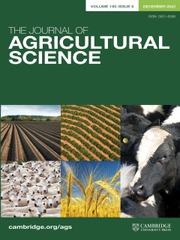No CrossRef data available.
Article contents
L-arginine modulates gene expression in the mammary glands of lactating sows and improves the weight uniformity of piglets at weaning
Published online by Cambridge University Press: 02 April 2025
Abstract
The objective was to evaluate the influence of supplementation of L-arginine at 10 g/kg on the performance of lactating sows and their litters by evaluating the milk amino acid composition, serum hormone levels, mammary tissue redox status indicators, mammary tissue histomorphology, and the expression of genes related to mammary gland metabolism. The study was conducted in the municipality of Oliveira, Minas Gerais, Brazil, in 2019. A total of 24 sows were selected. A completely randomized design was used in a 2 × 3 factorial arrangement, with two diets (control and 10 g L-arginine/kg) and three mammary gland positions (thoracic, abdominal and inguinal), totaling six treatment groups. Each dietary treatment consisted of 12 replicates, with each replicate equivalent to one experimental unit, which was considered a sow and its litter. Females that were fed a diet supplemented with L-arginine had lower feed intake and greater weight loss. Piglets from sows that received L-arginine supplementation presented reduced weaning weight variation. L-arginine supplementation did not affect the amino acid composition of the milk, the plasma hormone levels of the sows, the oxidative stress parameters of redox, or breast tissue morphology. However, it may modulate the expression of genes important for mammary gland metabolism, such as the COX1 and SLC27A4. Piglets that suckled teats in the thoracic and abdominal positions had higher mean weights at 14 and 23 days, as well as greater daily weight gains. L-arginine supplementation to sows improves litter quality by increasing weaning weight uniformity; piglets that occupy the thoracic and abdominal positions perform better.
Information
- Type
- Animal Research Paper
- Information
- Copyright
- © The Author(s), 2025. Published by Cambridge University Press


